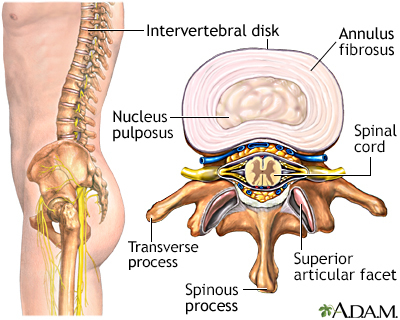Diskitis
Definition
Diskitis is swelling (inflammation) and irritation of the space between the bones of the spine (intervertebral disk space).
Alternative Names
Disk inflammation
Causes
Diskitis is an uncommon condition. It is usually seen in children younger than 10 years and in adults around 50 years of age. Men are more affected than women.
Diskitis can be caused by an infection from bacteria or a virus. It can also be caused by inflammation, such as from autoimmune diseases. Autoimmune diseases are conditions in which the immune system mistakenly attacks certain cells in the body.
Disks in the neck and low back are most commonly affected.
Symptoms
Symptoms may include any of the following:
- Abdominal pain
- Back pain
- Difficulty getting up and standing
- Fever (typically 102°F or 38.9°C or lower)
- Increased curvature of the back
- Irritability
- Neck pain
- Sweating at night
- Recent flu-like symptoms
- Refusal to sit up, stand, or walk (younger child)
- Stiffness in back
Exams and Tests
The health care provider will perform a physical exam and ask about the symptoms.
Tests that may be ordered include any of the following:
Treatment
The goal is to treat the cause of the inflammation or infection and reduce pain. Treatment may involve any of the following:
- Antibiotics if the infection is caused by bacteria
- Anti-inflammatory medicines if the cause is an autoimmune disease
- Pain medicines such as NSAIDs
- Bed rest or a brace to keep the back from moving
- Surgery if other methods don't work
Outlook (Prognosis)
Children with an infection should fully recover after treatment. In rare cases, chronic back pain persists.
In cases of autoimmune disease, the outcome depends on the underlying condition. These are often chronic illnesses that need long-term medical care.
Possible Complications
Complications may include:
- Persistent back pain (rare)
- Side effects of medicines
- Worsening pain with numbness and weakness in your limbs
When to Contact a Medical Professional
Contact your provider if you or your child has back pain that does not go away, or problems with standing and walking that seem unusual for the child's age.
Gallery


References
Mathew R, Hong DK. Diskitis. In: Long SS, Prober CG, Fischer M, Kimberlin DW, eds. Principles and Practice of Pediatric Infectious Diseases. 6th ed. Philadelphia, PA: Elsevier; 2023:chap 77.
Williams KD. Infections and tumors of the spine. In: Azar FM, Beaty JH, eds. Campbell's Operative Orthopaedics. 14th ed. Philadelphia, PA: Elsevier; 2021:chap 42.